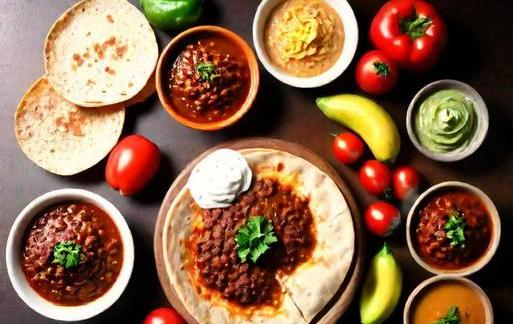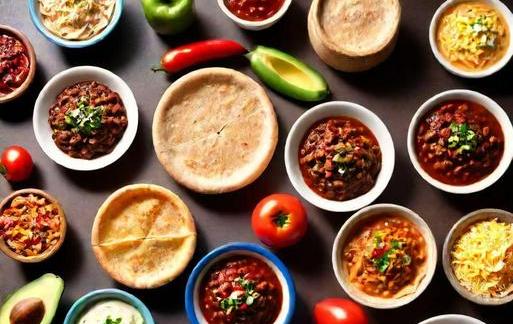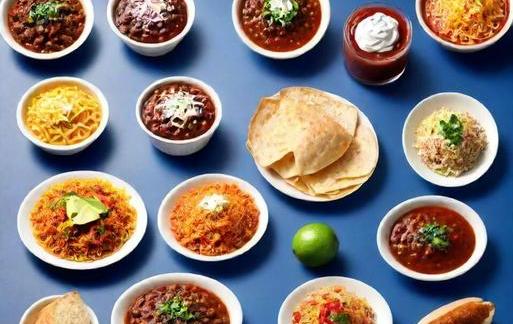- You are here:
- Home »
- Food
- » [REVEALED] Hispanic Foods That Start With F
[REVEALED] Hispanic Foods That Start With F
Note: This page contains affiliate links.
As an Amazon Associate, I earn from qualifying purchases when you click on the link, but you are not charged extra.
The rich tapestry of Hispanic cuisine is a culinary journey filled with vibrant flavors, diverse ingredients, and cultural significance. In this exploration, we delve into the realm of Hispanic foods that start with the letter "F." From savory to sweet, traditional to contemporary, these culinary delights showcase the depth and breadth of Hispanic gastronomy.
Contents
List Of Hispanic Foods That Start With F

1. Flautas
Description: Flautas, translating to "flutes" in Spanish, are rolled tortillas filled with various ingredients like shredded meat, cheese, or beans. These tightly rolled cylinders are then deep-fried until crispy, creating a delightful crunch. They are often served with guacamole, salsa, or sour cream.
Origin: Mexico
Cultural Significance: Flautas have deep roots in Mexican cuisine and are often enjoyed during celebrations and family gatherings. The crispy texture and flavorful fillings make them a favorite snack or appetizer.
2. Frijoles Refritos
Description: Frijoles refritos, or refried beans, are a staple in Hispanic cuisine. Pinto or black beans are cooked, mashed, and then fried with lard or oil. The result is a creamy, flavorful side dish that complements many traditional Hispanic meals.
Origin: Mexico
Cultural Significance: Refried beans are a versatile accompaniment, frequently found in burritos, tacos, and as a side dish. They add a hearty and comforting element to the plate.
3. Fideuà
Description: Fideuà is a delicious and distinctive dish similar to paella, but instead of rice, it features short noodles. Seafood, meat, or vegetables are combined with the noodles and cooked in a flavorful broth, creating a mouthwatering one-pan meal.
Origin: Spain
Cultural Significance: Originating from the coastal regions of Valencia, Fideuà is a popular dish during seaside celebrations. Its unique twist on traditional paella showcases the creativity within Hispanic culinary traditions.
4. Flan
Description: Flan is a creamy caramel custard dessert with a smooth, silky texture. It is made with eggs, sugar, and milk, creating a delightful combination of sweetness and richness. The dessert is inverted before serving, allowing the caramel sauce to cascade over the flan.
Origin: Spain
Cultural Significance: Flan has become a beloved dessert across many Hispanic cultures. Its origins in Spain spread to Latin America, where various regional adaptations have resulted in a diverse array of flan recipes.
5. Fideos
Description: Fideos refer to thin pasta noodles commonly used in Hispanic dishes. These noodles are often broken into small pieces and sautéed before being cooked in broth, creating a comforting soup. Fideos can also be used in casseroles or paired with various sauces.
Origin: Spain
Cultural Significance: Fideos have a strong presence in both Spanish and Latin American cuisines. They are a versatile ingredient, celebrated for their ability to absorb flavors in soups and stews.
6. Feijoada
Description: Feijoada is a hearty and flavorful stew made with black beans, pork, and beef. It typically includes sausages, bacon, and various cuts of meat, simmered together to create a rich and savory dish. Feijoada is often accompanied by rice and served during festive occasions.
Origin: Brazil
Cultural Significance: While Brazil is not a Spanish-speaking country, its cuisine shares many influences with Hispanic cultures. Feijoada, with its complex flavors and communal preparation, has become a symbol of Brazilian culinary heritage.
7. Fresas Con Crema
Description: Fresas con crema translates to "strawberries with cream." This simple yet delectable dessert consists of fresh strawberries topped with sweetened condensed milk or whipped cream. It’s a refreshing and indulgent treat.
Origin: Mexico
Cultural Significance: Fresas con crema is a popular dessert during warm weather in Mexico. The combination of juicy strawberries and creamy goodness makes it a delightful way to end a meal.
8. Fajitas
Description: Fajitas are a sizzling and savory dish featuring grilled strips of meat, often beef or chicken, served with sautéed peppers and onions. The components are typically wrapped in a tortilla, creating a flavorful and customizable handheld meal.
Origin: Mexico
Cultural Significance: Fajitas have gained widespread popularity, becoming a favorite in Tex-Mex cuisine. The interactive nature of assembling your fajita adds a communal and festive element to dining.
9. Farofa
Description: Farofa is a Brazilian dish made with toasted cassava or yuca flour, mixed with ingredients like bacon, onions, and herbs. It has a unique texture and a nutty flavor, often served as a side dish to complement meat-based meals.
Origin: Brazil
Cultural Significance: Farofa is a common accompaniment to Brazilian barbecue, adding a crunchy and flavorful element to the meal. Its roots in Afro-Brazilian cuisine contribute to the diversity of Brazilian gastronomy.
10. Flan Napolitano
Description: Flan Napolitano is a variation of traditional flan with a delightful twist. This creamy caramel custard includes cream cheese, giving it a velvety texture and a slightly tangy flavor. It is often served with a drizzle of caramel sauce.
Origin: Mexico
Cultural Significance: Flan Napolitano showcases the creativity of Mexican dessert makers. The incorporation of cream cheese adds a luxurious touch to the classic flan, making it a favorite for special occasions.
Exploring Hispanic foods that start with the letter "F" unveils a world of diverse flavors, culinary techniques, and cultural influences. From the savory delights of flautas and fajitas to the sweet indulgence of flan and fresas con crema, each dish tells a story of tradition, innovation, and the joy of communal dining. As we savor these Hispanic delicacies, we appreciate the interconnectedness of food and culture. Whether rooted in the streets of Mexico, the coastal regions of Spain, or the vibrant kitchens of Brazil, these "F" foods contribute to the rich tapestry of Hispanic gastronomy, inviting us to embrace the beauty of diverse tastes and culinary traditions.
Significance

Hispanic cuisine is a rich tapestry of flavors, textures, and traditions that spans across various countries and regions. From savory to sweet, the diverse range of dishes reflects the vibrant cultures that contribute to the Hispanic culinary landscape. In this exploration, we will delve into Hispanic foods that start with the letter "F." From familiar favorites to hidden gems, each dish unveils a unique story of heritage and taste.
The significance of Hispanic foods that start with the letter "F" lies in their ability to encapsulate the essence of Latin American and Spanish culinary traditions. These dishes not only offer a delicious culinary experience but also serve as a gateway to understanding the cultural diversity within the Hispanic world. Exploring the significance of these foods allows us to appreciate the historical, social, and geographical factors that have shaped their evolution.
Category-Related

1. Flan
Description: Flan, a quintessential dessert in Hispanic cuisine, is a creamy caramel custard with a velvety texture. It is made by combining eggs, sugar, and milk, creating a delightful contrast between the smooth custard and the rich caramel sauce.
Origin: Although its exact origins are debated, flan has deep roots in Spanish and Latin American culinary traditions. It has become a beloved dessert in countries such as Mexico, Spain, and Puerto Rico.
Preparation: Flan is prepared by caramelizing sugar, coating the bottom of a mold. A mixture of eggs, condensed milk, and vanilla is then poured over the caramel and baked to perfection.
2. Frijoles Refritos
Description: Frijoles refritos, or refried beans, are a staple in Hispanic cuisine. While the name might suggest double frying, the process actually involves cooking and mashing the beans after they have been boiled. This results in a creamy, flavorful side dish.
Origin: Originating in Mexican cuisine, frijoles refritos have become a popular accompaniment to many Latin American and Spanish dishes. The beans are typically pinto or black beans.
Serving: Frijoles refritos are often served as a side dish, in burritos, tacos, or alongside rice. They add a hearty and savory element to meals.
3. Feijoada
Description: Feijoada is a hearty and flavorful stew made with black beans, pork, and beef. It is often considered the national dish of Brazil and is a celebration of diverse meats and robust flavors.
Origin: Originating in Portugal, feijoada evolved in Brazil, where it became a symbol of the country’s cultural melting pot. It reflects the influence of African, Indigenous, and European culinary traditions.
Ingredients: The dish typically includes black beans, pork cuts such as sausages, bacon, and various meats like beef and sometimes lamb.
Common Themes
The Hispanic foods starting with "F" share common themes that tie them to the broader culinary landscape of Latin America and Spain. These themes highlight the use of simple yet flavorful ingredients, a focus on communal dining, and a deep connection to cultural heritage.
1. Culinary Fusion
Many of the Hispanic foods beginning with "F" showcase a beautiful fusion of culinary influences. For instance, feijoada from Brazil is a harmonious blend of African, Indigenous, and Portuguese flavors, reflecting the country’s diverse history. This culinary fusion is not only delicious but also a testament to the rich cultural tapestry of the Hispanic world.
2. Importance Of Family And Community
Hispanic cuisine places a strong emphasis on communal dining, where families and communities gather to share meals. Dishes like frijoles refritos are often served as sides, encouraging shared eating experiences. This communal aspect is deeply ingrained in the culture and reinforces the idea that meals are meant to be enjoyed together, fostering a sense of unity and connection.
3. Simple Ingredients, Complex Flavors
Many Hispanic dishes are crafted from simple, readily available ingredients that, when combined, create complex and satisfying flavors. Flan, for example, relies on basic elements like eggs, sugar, and milk, yet the result is a decadent dessert that delights the palate. This use of simple ingredients speaks to the resourcefulness of Hispanic cooks in creating delicious and memorable dishes.
Interesting Facts
1. Flan’s Global Influence
Flan, though deeply rooted in Hispanic cuisine, has transcended cultural boundaries and gained global popularity. Its velvety texture and rich caramel topping have made it a favorite dessert in countries far beyond the Hispanic world. In the United States, flan is often found on the dessert menus of diverse restaurants, showcasing its universal appeal.
2. Frijoles Refritos In Tex-Mex Cuisine
While frijoles refritos have Mexican origins, they have become a cornerstone of Tex-Mex cuisine. Popularized in the southwestern United States, refried beans are a key component in dishes like nachos, burritos, and enchiladas. This adaptation highlights the adaptability of Hispanic dishes in different culinary landscapes.
3. Feijoada’s Symbolism In Brazil
Feijoada is not just a dish in Brazil; it is a symbol of national identity. Often associated with gatherings, celebrations, and special occasions, feijoada represents the diversity and unity of the Brazilian people. Its preparation is considered an art, with variations existing across regions, showcasing the country’s rich cultural mosaic.
Conclusion
Exploring Hispanic foods that start with the letter "F" offers a journey into the heart of Latin American and Spanish culinary traditions. From the silky indulgence of flan to the robust flavors of feijoada, each dish tells a story of history, culture, and the joy of shared meals. The common themes of culinary fusion, communal dining, and the use of simple ingredients unite these diverse dishes under the umbrella of Hispanic cuisine. As we savor these flavors, we not only indulge our taste buds but also embrace the vibrant tapestry of the Hispanic culinary world.


